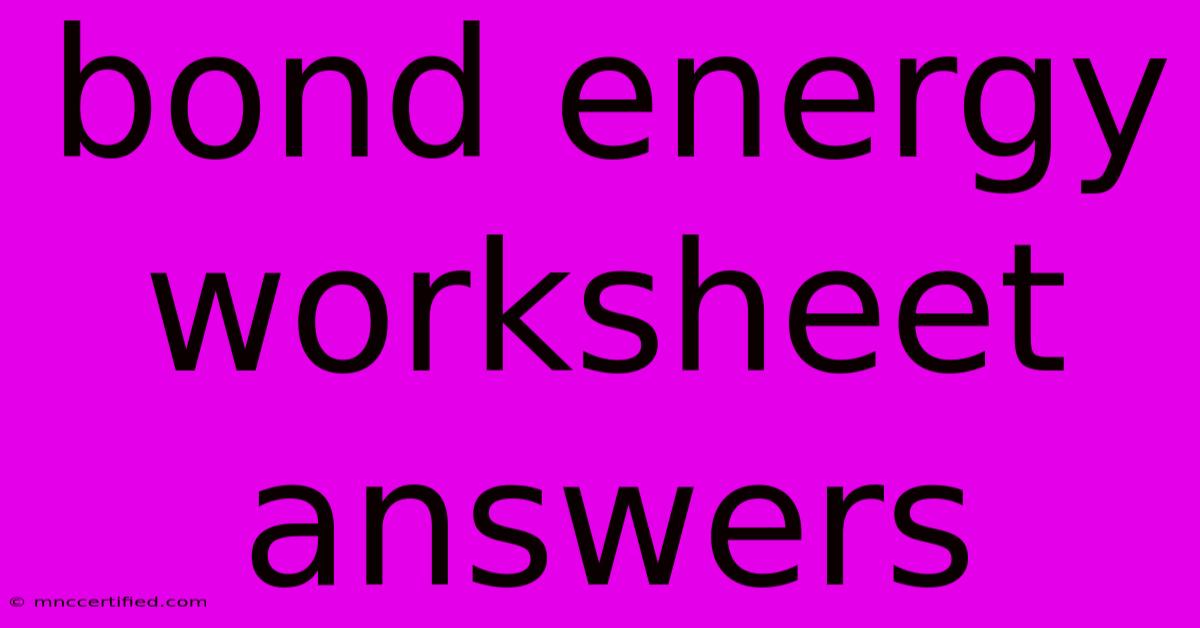Bond Energy Worksheet Answers

Table of Contents
Bond Energy Worksheet Answers: A Comprehensive Guide
Finding reliable answers to bond energy worksheets can be tricky. This comprehensive guide will not only provide you with the solutions but also equip you with a deeper understanding of bond energy, its calculation, and its applications. We'll cover key concepts, provide step-by-step examples, and offer strategies for tackling similar problems in the future.
Understanding Bond Energy
Bond energy, also known as bond dissociation energy, is the amount of energy required to break one mole of a particular bond in a gaseous molecule. It's a crucial concept in chemistry, providing insights into the stability of molecules and the energy changes involved in chemical reactions. Understanding bond energy is vital for predicting reaction enthalpy changes (ΔH) using Hess's Law.
Key Concepts to Master
Before diving into worksheet answers, let's review some fundamental concepts:
- Exothermic vs. Endothermic Bond Breaking: Breaking bonds always requires energy input (endothermic process). Forming bonds releases energy (exothermic process).
- Average Bond Energies: Because bond energy varies slightly depending on the molecule's environment, we often use average bond energies from tables. These are approximate values, but sufficient for many calculations.
- Hess's Law Application: Hess's Law states that the total enthalpy change for a reaction is independent of the pathway taken. This means we can use bond energies to calculate the enthalpy change of a reaction by summing the energies of bonds broken and formed.
Solving Bond Energy Problems: A Step-by-Step Approach
Let's illustrate with a typical worksheet problem:
Problem: Calculate the enthalpy change (ΔH) for the reaction: CH₄(g) + Cl₂(g) → CH₃Cl(g) + HCl(g) using average bond energies. Assume the following average bond energies (kJ/mol): C-H = 413, Cl-Cl = 242, C-Cl = 339, H-Cl = 431.
Solution:
- Identify Bonds Broken: In the reactants, we break four C-H bonds and one Cl-Cl bond.
- Calculate Energy Input (Bonds Broken): (4 × 413 kJ/mol) + (1 × 242 kJ/mol) = 1894 kJ/mol
- Identify Bonds Formed: In the products, we form three C-H bonds, one C-Cl bond, and one H-Cl bond.
- Calculate Energy Released (Bonds Formed): (3 × 413 kJ/mol) + (1 × 339 kJ/mol) + (1 × 431 kJ/mol) = 2010 kJ/mol
- Calculate ΔH: ΔH = Energy Input - Energy Released = 1894 kJ/mol - 2010 kJ/mol = -116 kJ/mol
Therefore, the enthalpy change for this reaction is -116 kJ/mol, indicating an exothermic reaction.
Common Mistakes to Avoid
- Incorrect Bond Counting: Double-check the number of each type of bond in reactants and products.
- Units: Ensure consistent units throughout the calculation (usually kJ/mol).
- Sign Convention: Remember that breaking bonds is endothermic (+), and forming bonds is exothermic (-).
Where to Find More Practice Problems and Answers
While providing specific worksheet answers here is impossible without knowing the specific questions, you can find many practice problems in chemistry textbooks, online resources, and educational websites. Search for "bond energy practice problems" or "bond enthalpy calculations" to find plenty of material. Many websites offer worked solutions or answer keys. Remember to focus on understanding the process rather than just memorizing answers.
Beyond the Worksheet: Real-World Applications of Bond Energy
Bond energy isn't just a theoretical concept; it has significant practical applications:
- Predicting Reaction Feasibility: Bond energy calculations help predict whether a reaction will be spontaneous or require energy input.
- Designing New Molecules: Chemists use bond energy data to design molecules with desired properties and stabilities.
- Understanding Reaction Mechanisms: Bond energy helps explain the steps involved in complex chemical reactions.
By mastering the concepts of bond energy and practicing with various problems, you can confidently tackle any worksheet and apply this knowledge to a broader understanding of chemistry. Remember that consistent practice and a thorough understanding of the underlying principles are key to success.

Thank you for visiting our website wich cover about Bond Energy Worksheet Answers. We hope the information provided has been useful to you. Feel free to contact us if you have any questions or need further assistance. See you next time and dont miss to bookmark.
Featured Posts
-
Bond Arms Snake Slayer Review
Nov 28, 2024
-
Champions League Villa Juventus Lineups
Nov 28, 2024
-
Storm Conall Warning Hundreds In Danger
Nov 28, 2024
-
Live Aston Villa Vs Juventus Champions League Final
Nov 28, 2024
-
Live Stream Liverpool Vs Real Madrid Ucl
Nov 28, 2024